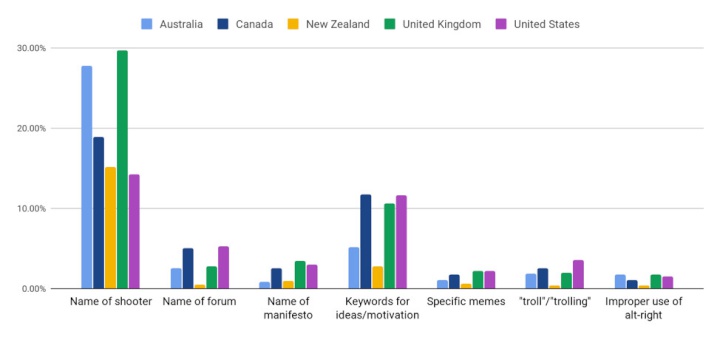US Media Watchdog Columbia Journalism Review (CJR) has recently published a report titled: "What we learned from analyzing thousands of stories on the Christchurch shooting"
After the Christchurch massacre, CJR used Media Cloud, an open-source media analysis tool developed at MIT’s Center for Civic Media and Harvard’s Berkman Klein Center, to analyse news sources to see how outlets complied with guidelines from groups that seek to limit the amplification of terrorist acts through media.
Method
CJR analysed 6,337 stories from 508 national-level English-language news sources in New Zealand, Australia, Canada, the United Kingdom, and the United States.
CJR coded for compliance with the following best practices:
1. Don’t publish the
shooter’s name.
2. Don’t link to or publish the name
of the forum that the shooter posted on to promote the
attacks.
3. Don’t link to or publish the name of the
shooter’s manifesto.
4. Don’t describe or detail the
shooter’s ideology.
5. Don’t publish or name specific
memes linked to the shooter’s ideology.
6. Don’t
refer to the shooter as a troll or his actions as
trolling.
7. Follow the AP guidelines for using the term
“alt-right” (contain it within quotation marks or modify
it with language such as “so-called” or
“self-described”).
In addition, they coded for stories that “focused specifically on the victims or mentioned Islamophobia as a cause in the killings.”
Findings
The graph below shows what guidelines publications in different countries violated.

Regarding NZ coverage CJR said:
“The New Zealand Herald, which ran 11 stories shared more than 50,000 times, violated four of the guidelines, more than almost all other New Zealand outlets. Some outlets may look at their social media metrics and conclude that they need to publish sensitive details of the massacre to retain readers.”
And regarding National differences;
“There’s a small difference in adherence to these guidelines between media without a print or broadcast presence, and those that are non-digitally native (see the graph below). However, it’s less significant a difference than the apparent difference in national standards between countries like the US and NZ, which were largely compliant, and those like the UK and Australia, which were less so.”
CJR concluded from these findings, that more journalists are stepping back from the “who, what, where, how, and why” to questions of how to prevent tragedy.
However, they point out that with platforms as a distribution system, this problem is much more complicated. “Digitization has made local news globally accessible, and it’s a very short distance from ‘It can’t happen here’ to ‘It’s happening everywhere.’ ”



 DC Harding: In The Spirit Of Natural Justice
DC Harding: In The Spirit Of Natural Justice Martin LeFevre - Meditations: Animal Encounters During Meditative States
Martin LeFevre - Meditations: Animal Encounters During Meditative States Ian Powell: Gisborne Hospital Senior Doctors Strike Highlights Important Health System Issues
Ian Powell: Gisborne Hospital Senior Doctors Strike Highlights Important Health System Issues Keith Rankin: Who, Neither Politician Nor Monarch, Executed 100,000 Civilians In A Single Night?
Keith Rankin: Who, Neither Politician Nor Monarch, Executed 100,000 Civilians In A Single Night? Eugene Doyle: Writing In The Time Of Genocide
Eugene Doyle: Writing In The Time Of Genocide Gordon Campbell: On Wealth Taxes And Capital Flight
Gordon Campbell: On Wealth Taxes And Capital Flight